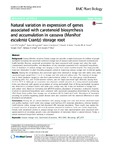Please use this identifier to cite or link to this item:
http://www.alice.cnptia.embrapa.br/alice/handle/doc/1051346| Title: | Natural variation in expression of genes associated with carotenoid biosynthesis and accumulation in cassava (Manihot esculenta Crantz) storage root. |
| Authors: | CARVALHO, L. J. C. B.  AGUSTINI, M. A. V.   ANDERSON, J. V.   VIEIRA, E. A.   SOUZA, C. R. B. de   CHEN, S.   SCHAAL, B. A.   SILVA, J. P. da   |
| Affiliation: | LUIZ JOAQUIM CASTELO B CARVALHO, Cenargen; MARCO A. V. AGUSTINI, Cenargen; JAMES V. ANDERSON, USDA ARS; EDUARDO ALANO VIEIRA, CPAC; CLAUDIA R. B. DE SOUZA, UFPA; SONGBI CHEN, Chinese Acad Trop Agr, Trop Crops Genet Resources Inst; BARBARA A. SCHAAL, Washington Univ; JOSEANE PADILHA DA SILVA, Cenargen. |
| Date Issued: | 2016 |
| Citation: | BMC Plant Biology, v. 16, n. 1, 2016. |
| Description: | ABSTRACT: BACKGROUND: Cassava (Manihot esculenta Crantz) storage root provides a staple food source for millions of people worldwide. Increasing the carotenoid content in storage root of cassava could provide improved nutritional and health benefits. Because carotenoid accumulation has been associated with storage root color, this study characterized carotenoid profiles, and abundance of key transcripts associated with carotenoid biosynthesis, from 23 landraces of cassava storage root ranging in color from white-to-yellow-to-pink. This study provides important information to plant breeding programs aimed at improving cassava storage root nutritional quality. RESULTS: Among the 23 landraces, five carotenoid types were detected in storage root with white color, while carotenoid types ranged from 1 to 21 in storage root with pink and yellow color. The majority of storage root in these landraces ranged in color from pale-to-intense yellow. In this color group, total ß-carotene, containing all-E-, 9-Z-, and 13-Z-ß-carotene isomers, was the major carotenoid type detected, varying from 26.13 to 76.72 %. Although no ?-carotene was observed, variable amounts of a ?-ring derived xanthophyll, lutein, was detected; with greater accumulation of ?-ring xanthophylls than of ß-ring xanthophyll. Lycopene was detected in a landrace (Cas51) with pink color storage root, but it was not detected in storage root with yellow color. Based on microarray and qRT-PCR analyses, abundance of transcripts coding for enzymes involved in carotenoid biosynthesis were consistent with carotenoid composition determined by contrasting HPLC-Diode Array profiles from storage root of landraces IAC12, Cas64, and Cas51. Abundance of transcripts encoding for proteins regulating plastid division were also consistent with the observed differences in total ß-carotene accumulation. CONCLUSIONS: Among the 23 cassava landraces with varying storage root color and diverse carotenoid types and profiles, landrace Cas51 (pink color storage root) had low LYCb transcript abundance, whereas landrace Cas64 (intense yellow storage root) had decreased HYb transcript abundance. These results may explain the increased amounts of lycopene and total ß-carotene observed in landraces Cas51 and Cas64, respectively. Overall, total carotenoid content in cassava storage root of color class representatives were associated with spatial patterns of secondary growth, color, and abundance of transcripts linked to plastid division. Finally, a partial carotenoid biosynthesis pathway is proposed. |
| Thesagro: | Mandioca Armazenamento |
| NAL Thesaurus: | Cassava Storage Carotenoids DNA microarrays |
| Keywords: | Caretonóide HPLC-DAD Micromatrizes de DNA QRT PCR |
| DOI: | 10.1186/s12870-016-0826-0 |
| Type of Material: | Artigo de periódico |
| Access: | openAccess |
| Appears in Collections: | Artigo em periódico indexado (CPAC)  |
Files in This Item:
| File | Description | Size | Format | |
|---|---|---|---|---|
| naturalvariation.pdf | 3.29 MB | Adobe PDF |  View/Open |









